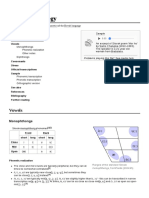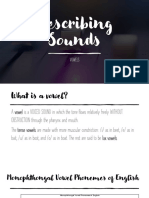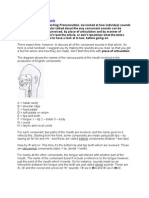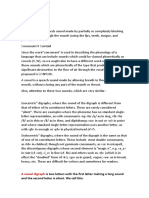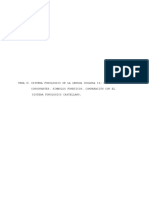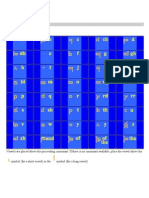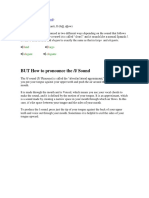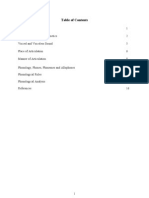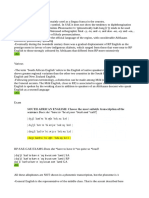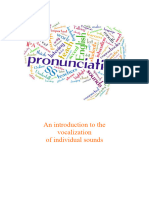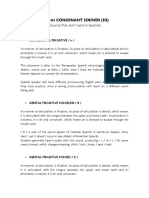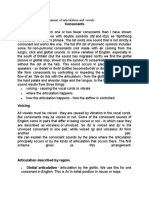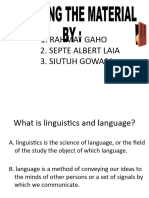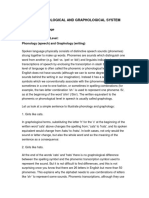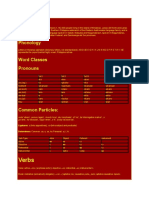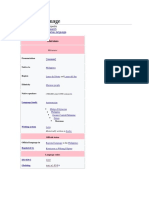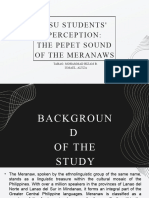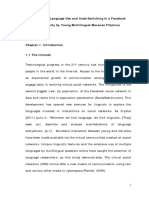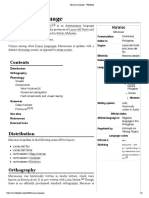0 ratings0% found this document useful (0 votes)
101 viewsGrammar Sketch
Grammar Sketch
Uploaded by
quitzilipoctliThe document provides information on the phonology and writing systems of several Philippine languages:
- Chabacano has 31 letters including those from Spanish and Tagalog. Vowels have five sounds and consonants may be interchangeable.
- Masbatenyo uses symbols for its vowels and consonants. Vowels have front, central, and back variations. Glottal stops are represented.
- Maranao's alphabet is described along with variations in pronunciation of its vowels from English. The digraph 'ae' has no English equivalent.
- Other languages discussed include Batad Ifugao, Bikol, and Dumagat, with descriptions of their consonants, vowels,
Copyright:
© All Rights Reserved
Available Formats
Download as DOCX, PDF, TXT or read online from Scribd
Grammar Sketch
Grammar Sketch
Uploaded by
quitzilipoctli0 ratings0% found this document useful (0 votes)
101 views7 pagesThe document provides information on the phonology and writing systems of several Philippine languages:
- Chabacano has 31 letters including those from Spanish and Tagalog. Vowels have five sounds and consonants may be interchangeable.
- Masbatenyo uses symbols for its vowels and consonants. Vowels have front, central, and back variations. Glottal stops are represented.
- Maranao's alphabet is described along with variations in pronunciation of its vowels from English. The digraph 'ae' has no English equivalent.
- Other languages discussed include Batad Ifugao, Bikol, and Dumagat, with descriptions of their consonants, vowels,
Original Description:
grammar sketch of several Filipino languages
Copyright
© © All Rights Reserved
Available Formats
DOCX, PDF, TXT or read online from Scribd
Share this document
Did you find this document useful?
Is this content inappropriate?
The document provides information on the phonology and writing systems of several Philippine languages:
- Chabacano has 31 letters including those from Spanish and Tagalog. Vowels have five sounds and consonants may be interchangeable.
- Masbatenyo uses symbols for its vowels and consonants. Vowels have front, central, and back variations. Glottal stops are represented.
- Maranao's alphabet is described along with variations in pronunciation of its vowels from English. The digraph 'ae' has no English equivalent.
- Other languages discussed include Batad Ifugao, Bikol, and Dumagat, with descriptions of their consonants, vowels,
Copyright:
© All Rights Reserved
Available Formats
Download as DOCX, PDF, TXT or read online from Scribd
Download as docx, pdf, or txt
0 ratings0% found this document useful (0 votes)
101 views7 pagesGrammar Sketch
Grammar Sketch
Uploaded by
quitzilipoctliThe document provides information on the phonology and writing systems of several Philippine languages:
- Chabacano has 31 letters including those from Spanish and Tagalog. Vowels have five sounds and consonants may be interchangeable.
- Masbatenyo uses symbols for its vowels and consonants. Vowels have front, central, and back variations. Glottal stops are represented.
- Maranao's alphabet is described along with variations in pronunciation of its vowels from English. The digraph 'ae' has no English equivalent.
- Other languages discussed include Batad Ifugao, Bikol, and Dumagat, with descriptions of their consonants, vowels,
Copyright:
© All Rights Reserved
Available Formats
Download as DOCX, PDF, TXT or read online from Scribd
Download as docx, pdf, or txt
You are on page 1of 7
Chabacano Language
The Chabacano language has 31 letters:
a b c ch d e f g h i j k l ll m n
ng o p q r rr s t u v w x y z
It has all the letters found in the English alphabet in addition to the following letters
found in either Spanish or Tagalog.
ch: Chabacano
ll: cuello
ng: nga
: ora
rr: perro
The five vowels have only five corresponding sounds retaining the original sounds found
in the original sounds found in Tagalog and Spanish.
Allophones are found in both vowels and consonants as in /f/ and /p/, /b/ and /v/, /l/ and
/r/.
/e/ and /i/ may be interchangeable but only /i/ substituting /e/ but no the other way
around. Also, the exchange may occur in the initial and final /e/ sound but not in
medial position. Whenever the /i/ substitutes the /e/, the resulting sound will be
somewhere between the two but veering towards the /i/ sound.
Similarly with the /o/ and /u/. The /u/ may substitute the /o/ sound but only in the
final position and at times at the initial position if it ends the syllable but not in the
medial. The substituting sound is somewhere between /o/ and /u/ sounds.
However the /u/ sound is not substituted by /o/.
Diphthongs occur when combination of vowels are found and treated as one distinct
sound.
Blends occur especially with the following common word combines:
no hay - o in no becomes u and the h disappears; the result is [nu-AY]
ta followed by a words starting with a, often, the succeeding a disappears like ta
alla becomes talla [tal-YA], ta aqui becomes taqui [ta-KI].
Shifting of stress occurs in some instances thus changing the meaning and the use of
words.
The verb is usually stressed on the last syllable.
Masbatenyo language
Symbols used for the Masbatenyo language:
A B C D E G H I K L M N NG O P R S T U W Y
[-] and [`] glottal stop
['] stress or accent
[^] represents the concurrence of stress and glottal stop on the same syllable
Vowels
Front Central Back
High i u
Mid e o
Low a
['] (Accent)
The two vowels [e] and [o] are distinctive only in load words from Spanish or English.
Otherwise they are variants of /i/ and /u/ respectively.
Consonants
Bilabial Alveolar Palatal Velar Glottal
Stops:
voiceless
voiced
p
t
k
(-,`)
b d g
Fricatives s h
Nasals m n ng
Lateral l
Flapped r
Semivowels w y
The glottal stop is symbolized by [-] when it is a member of a consonant cluster in the
middle of words, and by a grave accent [`] on a vowel with a following glottal stop.
Maranao language
The following symbols have been used for the Maranao alphabet:
/a/ /b/ /d/ /ae/ /e/ /g/ /h/ /i/ /k/ /j/ /l/ /m/ /n/ /ng/ /o/ /p/ /s/ /t/ /w/ /y/
Most of the consonants are pronounced with their usual phonetic value. The /'/
indicates the glottal stop, /ng/ the velar nasal, and /r/ a flap.
The vowel sounds, on the other hand, are not to be equated with English
pronunciations. The letter a is usually pronounces as the /a/ of father (tabas cut),
though it may be sometimes be heard by the American a bit higher and thus as the /a/
of sofa. The letter /i/ is usually pronounced as the /i/ of machine (lima 'five'), though in
some positions (antepenultimate, or even penultimate syllables ) it varies almost to the
/e/ of met (lamisa'an 'table'). The /o/ varies between /ui/ of suit, the /oo/ of soot, and the
/oa/ of boat (dato 'chief', solotan 'sultan'). The pronunciation is often the high back
sound [u], especially in ultimate position, but the variation to the American ear is
striking.
The digraph /ae/ in Maranao represents the Philippines pepet vowel for which the
American has no equivalent. It is technically a central high vowel and is pronounced
with the tongue in a fairly high position with considerable tension. It resembles the /u/ in
just in the common rapid pronunciation [jst]. The /e/ in Maranao is central like the
schwa (/a/ in sofa), but it is mid tense, or perhaps high lax, a bit lower than the
pepet and not as tense.
The /w/ and /y/ in Maranao are non-syllabic varieties of the /o/ and /i/
respectively. In the first edition of the dictionary, we wrote these sounds with the
/o/ and /i/, but later, after an orthography conference and more experience with
Marano readers and writers, opted for indicating the non-syllabic sounds with the
semi-vowels. The user will note that the semi-vowels occur in general non-
adjacent to a consonant (aya 'this').
Batad Ifugao language
Consonants
Bilabial Alveolar Velar Pharyngeal
Obstruents:
voiceless
voiced
p
t
k
glottal stop (')
b d g
Sonorants:
nasal
m
n
oral w l y h
Vowels
Front Central Back
High i
u
Low e a o
Bikol Language
Consonants
Labial Dental Alveolar Palatal Velar Glottal
Stops
Fricatives
Affricates
Nasals
Laterals
Flap
Semi-Vowels
Vowels
Front Central Back
High i u
Mid e o
Low a
Dipthongs
i + u iw
a + i ay
a + u ~ o aw
o ~ u + i oy ~ uy
Dumagat (Casiguran) Language
Consonants
The consonant phonems of Casiguran Dumagat are: p, t, k, b, d, g, s, h, m, n, ng, l, r, w,
y, and glottal stop. Most of the consonant symbols have their usual phonetic value.
The diagraph ng represents the velar nasal, and r is an alveolar flap.
Stops are unaspirated. Glottal stop is not symbolized, except in the few instances where
it occurs following a consonant, where it is then represented by a hyphen. Since no
utterance initial or final vowels occur, a word such as aso "dog", is to be read as
beginning and ending with a glottal stop. Similarly, since no vowel clusters occur, words
written with two vowels together are to be read as having a glottal stop between the
vowels.
Vowels
There are eight vowel phonemes in Casiguran Dumagat: a, e, , , i, o, , u. a is low
central, e is mid close front, is mid open front, is mid close central, i is high front, o is
mid close back, is mid open back, and u is high back, as shown in Table 3.
TABLE 3: PHONETIC QUALITY OF VOWEL PHONEMES
Front Central Back
High i u
Mid close
open
e
o
Low a
Sources:
Escalante, E. Chabacano...for everyone: a guide to the Chabacano language (2005).
Baby Dragon Printing Press. Manila.
Headland, T. and Headland, J. A Dumagat (Casiguran) - English Dictionary (1974).
Linguistic Circle of Canberra. Australia.
McKaughan, H. (ed.). A Marano Dictionary (1996). De La Salle University Press, Inc.
Manila.
Mintz, M. Bikol Dictionary (1971). University of Hawaii. Honolulu.
Newel, L. Batad (comp.). Ifugao Dictionary with Ethnographic Notes (1993). Linguistic
Society of the Philippines. Manila.
Wolfenden, E. (comp.). A Masbatenyo - English Dictionary (2001). Linguistic Society of
the Philippines. Manila.
You might also like
- Vietnamese Picture Dictionary: Learn 1,500 Vietnamese Words and Expressions - The Perfect Resource for Visual Learners of All Ages (Includes Online Audio)From EverandVietnamese Picture Dictionary: Learn 1,500 Vietnamese Words and Expressions - The Perfect Resource for Visual Learners of All Ages (Includes Online Audio)No ratings yet
- Slovak PhonologyDocument8 pagesSlovak PhonologyMetaleiroNo ratings yet
- 1.2 Describing Sounds (Lesson 2)Document14 pages1.2 Describing Sounds (Lesson 2)James CancinoNo ratings yet
- Mod5 Iluko PhonologyDocument11 pagesMod5 Iluko PhonologyLara Angela RigorNo ratings yet
- PHONETICSDocument8 pagesPHONETICSbganolalNo ratings yet
- English ConsonantsDocument3 pagesEnglish ConsonantsKashif Farid0% (1)
- A Vowel Digraph: Is Two Letters With The First Letter Making A Long Sound and The Second Letter Is Silent. We Call ThisDocument6 pagesA Vowel Digraph: Is Two Letters With The First Letter Making A Long Sound and The Second Letter Is Silent. We Call ThisErica EllenNo ratings yet
- Tema 8: Sistema Fonologico de La Lengua Inglesa Ii: Las Consonantes. Simbolos Foneticos. Comparación Con El Sistema Fonologico CastellanoDocument14 pagesTema 8: Sistema Fonologico de La Lengua Inglesa Ii: Las Consonantes. Simbolos Foneticos. Comparación Con El Sistema Fonologico CastellanoLorraineNo ratings yet
- PhonemesDocument10 pagesPhonemesFanni MajorNo ratings yet
- Spanish AlphabetDocument6 pagesSpanish Alphabet鲁肃津No ratings yet
- Phonetics, Week 5, Part Two. Classification of Vowels-1Document22 pagesPhonetics, Week 5, Part Two. Classification of Vowels-1Brwa KamilNo ratings yet
- What Are ConsonantsDocument3 pagesWhat Are ConsonantsOlguita MalandritaNo ratings yet
- Allophonic Variants For English ConsonantsDocument11 pagesAllophonic Variants For English ConsonantsSergio Vargas0% (1)
- Examples and Observations: EtymologyDocument8 pagesExamples and Observations: EtymologyDessy FitriyaniNo ratings yet
- Phonetics and Phonology I-VowelsDocument28 pagesPhonetics and Phonology I-Vowelsalejandro pintoNo ratings yet
- Kratka Francuska GramatikaDocument29 pagesKratka Francuska GramatikaAmmmmNo ratings yet
- Tolkien, J. R. R. - Tengwar AlphabetDocument12 pagesTolkien, J. R. R. - Tengwar AlphabetJuan Dela Vega100% (1)
- Introduction To ENG ConsonantsDocument4 pagesIntroduction To ENG Consonantskamsyplus1676No ratings yet
- Phonetic and Phonology II HANDOUTDocument6 pagesPhonetic and Phonology II HANDOUTannerysNo ratings yet
- Phonetics and PhonologyDocument13 pagesPhonetics and Phonologynikol.elias2305No ratings yet
- Fonética, Conceptos Básicos.Document4 pagesFonética, Conceptos Básicos.Paula LópezNo ratings yet
- CONSONANTSDocument6 pagesCONSONANTSnadia nur ainiNo ratings yet
- PhonologyDocument31 pagesPhonologyyokaj18372No ratings yet
- Consonant Sound L and Dark LDocument4 pagesConsonant Sound L and Dark LMariel AguirreNo ratings yet
- Rule Full EngDocument5 pagesRule Full EngbasharNo ratings yet
- Hangeul: Welcome To The Korean For English Speakers Course!Document10 pagesHangeul: Welcome To The Korean For English Speakers Course!Daniela BlancoNo ratings yet
- The Distinctive CompositionDocument5 pagesThe Distinctive Compositionsofija manaievaNo ratings yet
- Linguistics Kelompok 3Document17 pagesLinguistics Kelompok 3Salman Farizi100% (1)
- Examples of Allophones: Wool: LoveDocument2 pagesExamples of Allophones: Wool: LoveAzzahra NatasyaNo ratings yet
- Dealing With Difficult English Sounds For Brazilian StudentsDocument33 pagesDealing With Difficult English Sounds For Brazilian StudentsCaio AntônioNo ratings yet
- Consonants of English: Presented by Marwa Mahmoud Abd El FattahDocument8 pagesConsonants of English: Presented by Marwa Mahmoud Abd El FattahSamar Saad100% (2)
- Fonetic NotesDocument5 pagesFonetic Notessteamimon2No ratings yet
- Daypo SAEDocument9 pagesDaypo SAEMaria.Fer79No ratings yet
- PhonolDocument6 pagesPhonolAvinash RawalNo ratings yet
- Phonology - IntroductionDocument13 pagesPhonology - IntroductionDiego Martiez barreiroNo ratings yet
- Sound FoundationsDocument3 pagesSound FoundationsThales NicolettiNo ratings yet
- English Consonant Sounds III (Sounds Not Existing in Spanish)Document6 pagesEnglish Consonant Sounds III (Sounds Not Existing in Spanish)Jazmin SanabriaNo ratings yet
- Ppoint 55Document11 pagesPpoint 55Enaknya nge-gameNo ratings yet
- Syllable, Word Stress, WV, Neutralized Vowels, ElisionDocument29 pagesSyllable, Word Stress, WV, Neutralized Vowels, ElisionGaby Micaela RuizNo ratings yet
- Phonetics and Oral English LessonDocument6 pagesPhonetics and Oral English LessonZenn Maia GuerreroNo ratings yet
- Dr. Riceli C. Mendoza University of Southern Mindanao PhilippinesDocument17 pagesDr. Riceli C. Mendoza University of Southern Mindanao PhilippinesJose Luis Gatillon SotoNo ratings yet
- Consonants Place and Manner of Articulation and VowelsDocument11 pagesConsonants Place and Manner of Articulation and VowelsKrisha EderaNo ratings yet
- Vowel SoundsDocument12 pagesVowel SoundsoserobritonNo ratings yet
- Phonics RulesDocument18 pagesPhonics RulesAisy Astarina100% (1)
- Phonology.1 PHONEMEDocument16 pagesPhonology.1 PHONEMEMOHAMMAD AGUS SALIM EL BAHRI100% (3)
- ConsonantsDocument2 pagesConsonantsFaisal AkbarNo ratings yet
- Phonetics PDFDocument29 pagesPhonetics PDFMUHAMMAD SHAHIDNo ratings yet
- 2 Seminar TypologyDocument32 pages2 Seminar TypologytoshkulovagulasalNo ratings yet
- Phonetics III - Consonants and VowelsDocument9 pagesPhonetics III - Consonants and VowelsAbdelkarim BouhNo ratings yet
- Speech and Oral Communication ModuleDocument8 pagesSpeech and Oral Communication ModuleShiela MirandaNo ratings yet
- English Phonological and Graphological SystemDocument10 pagesEnglish Phonological and Graphological SystemBeverly100% (1)
- Phonetics Vs Phonology 1Document3 pagesPhonetics Vs Phonology 1Saheli GuptaNo ratings yet
- Phonetics Lectures Semester OneDocument7 pagesPhonetics Lectures Semester Oneandrey29ovNo ratings yet
- Types of Allophones and Their UsesDocument9 pagesTypes of Allophones and Their UsesDanielGonzálezZambrano86% (7)
- PhoneticsDocument110 pagesPhoneticshafid100% (1)
- Edital 01 Da Monitoria 2018.1Document8 pagesEdital 01 Da Monitoria 2018.1Anonymous 0uOPyTUwkNo ratings yet
- Question 2-Vowels EssayDocument4 pagesQuestion 2-Vowels EssaySyauqi ZamryNo ratings yet
- Paganad Ka Sa Basa MaranaoDocument4 pagesPaganad Ka Sa Basa MaranaoAnonymous EvbW4o1U7No ratings yet
- Maranao LanguageDocument6 pagesMaranao LanguageMau Mau MauNo ratings yet
- The Pepet Sound of The MeranawsDocument13 pagesThe Pepet Sound of The MeranawsAna Jannah YASSERNo ratings yet
- A Grammar of Mëranaw LanguageDocument8 pagesA Grammar of Mëranaw LanguageInternational Journal of Innovative Science and Research Technology100% (1)
- Temporan National High School 7-Pearl Cyril A. Verdadero English 7 7:15-8:15 First Quarter, Week2 Monday Tuesday Wednesday Thursday FridayDocument4 pagesTemporan National High School 7-Pearl Cyril A. Verdadero English 7 7:15-8:15 First Quarter, Week2 Monday Tuesday Wednesday Thursday FridayCyril VerdaderoNo ratings yet
- Maranao Flora and FaunaDocument6 pagesMaranao Flora and FaunaAngel Grace TiempoNo ratings yet
- Dissertaion (Latip-Yusoph Sorhaila)Document109 pagesDissertaion (Latip-Yusoph Sorhaila)hcheesedog097No ratings yet
- LR Inventory 08 2022Document799 pagesLR Inventory 08 2022Lancelot BaroqueNo ratings yet
- Grammar SketchDocument7 pagesGrammar SketchquitzilipoctliNo ratings yet
- Maranao Language - WikipaasdediaDocument6 pagesMaranao Language - WikipaasdediaSebastian Pacao100% (1)
- VICTORIA DISTRICT Inventory of LRs SUMMARY ELEMENTARY AND SECONDARYDocument32 pagesVICTORIA DISTRICT Inventory of LRs SUMMARY ELEMENTARY AND SECONDARYNell Sabas AdolfoNo ratings yet

